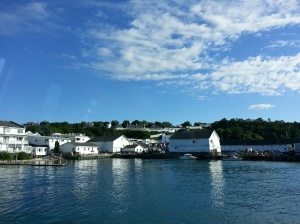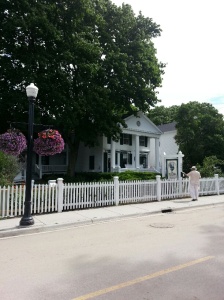
Land of Promise – The Story of The Northwest Territory, by Walter Havighurst (NY: Macmillan, 1946)
Here is yet another wonderful book which we discovered on our recent book scouting trip. An author-signed first edition, I bought it to read prior to offering it for sale, because it had me at hello with it’s lovely dust jacket illustration and it’s excellent prose. What a pleasurable reading experience! The book is rich in detail on the early history and settlement of the upper Midwestern United States, which in our country’s youth was known as “The “Northwest Territory.” It is a page-turner, and kept me awake into the wee hours many a night; had me reaching for the atlas to look up locations being discussed, even planning road trips to explore the places brought to life through the author’s words.

Endpaper maps from “Land of Promise – The Story of the Northwest Territory”
Here is a paragraph regarding the “Mound Builders” of Ohio:
“Above the wooded gorge of the Little Miami River on its way to the Ohio is Fort Ancient, the greatest military stronghold in prehistoric America. Its grass and tree-grown walls extend four miles and enclose a hundred acres in two rudely triangular areas connected by a serpentine passageway. Thousands of travelers have wondered at its irregular shape and some have seen clearly marked the outlines of North and South America, joined by the sinuous Isthmus of Panama. So they credit the Mound Builders of a thousand years ago with a knowledge of geography that no European possessed until centuries later.”
Here are incredible stories from an incredible time in the history of mankind, as early explorers, missionaries, fur traders, followed by settlers moved into unknown territory from the original east coast colonies across the Alleghenies and Appalachians into the wilds of the Midwest. There is the story of the race to claim the land by the French, the British, and the Americans, all of it long occupied by Native American Tribes. Then the intrepid surveyors who followed with chain and compass – laying out the sections of land for settlement in places where the wolves howled at night, mosquitoes feasted on them by day, in country that was rough, isolated and difficult. “They waited, sometimes weeks on end, for an observation of the stars to clinch their meridian.”
It is also a story of riches found and quickly depleted by man…rich soil, bountiful fur, game, timber, iron and copper. Here were expansive waterways–broad rivers and Great Lakes, at first mistaken for oceans and a route to the riches of the Orient…which in time became great shipping lanes for American commerce.
And then there are tales like this one, which make you want to grab a shovel and map and set out on a quest:
As a political maneuver In 1749, Celeron de Blainville was sent to reaffirm the authority of France in the upper Ohio Valley…
“In his canoe was an article of baggage which had added to the toil of the portages. A box, sturdily built and surprisingly heavy for its size, was packed with lead plates, on each of which was printed a declaration of possession “…of said river Ohio, and of all those that therein empty; and of all the land on both sides of said river.” At the mouth of each important tributary to the Ohio the party moored their canoes, drew up in military ranks on the shore and buried a lead plate in the soft soil. Then to a nearby sycamore or willow trunk Celeron nailed a tin plaque bearing the arms of France and giving the location of the buried plate and repeating its inscription.
Years after the French claim to that country was forgotten, two of the buried plates were found. At the mouth of the Muskingum a group of Marietta boys dug a heavy lead slab from an eroded place on the river bank. They cut off a corner to make rifle bullets, but the remainder of that plate is now in the museum of the American Antiquarian Society at Worcester, Massachusetts. Another plate, removed from the mouth of the Great Kanawha, is now in possession of the Virginia Historical Society at Richmond. The rest are still buried at the river mouths.”
The route to the new lands was first by canoe, raft or sailing ship, or on foot; later by wagons or coaches over rough roads…and then by steam powered ships and boats. Canals were built to link lakes and communities; then the trains came. This history of the development of America’s heartland is filled with little known facts about astounding yet little known people, as well as details on the lives of those who became legends, like Jonathan Chapman, better known as Johnny Appleseed.
The growth of cities, with their destinies determined by waterways, railroads and sometimes pure chance, is brought forth in detail and peppered with many intriguing facts. Chicago (not expected to grow large) was built upon sloppy marshland; in the 1850’s, a huge project ensued where most of the city’s buildings and roads had to be raised 4 to 8 feet. In 1858, the Tremont House, a big brick four-story hotel, was one of the last buildings to remain at the old level. No one had mustered the courage to lift it out of the mud. George Pullman (later of Pullman railroad car fame), tackled the job and completed it in seven weeks with twelve hundred men.
Walter Havighurst wrote many fine books, including The Long Ships Passing – The Story of the Great Lakes. His first book, Pier 17 (Macmillan, 1935), was a novel about a waterfront strike on the west coast, and was nominated for the Pulitzer Prize.

The Long Ships Passing – The Story of the Great Lakes, by Walter Havighurst
His biography and bibliography is available here.
Havighurst died in 1994. In his Eulogy, Philip R. Shriver wrote: “Through the years, Walter gained a mastery of the English language equaled by few. He possessed a rare talent for using words, finding through their combinations melody, harmony, and tone. L. Scott Bailey, a 1948 Miami graduate, once said of Walter that “he could set my soul humming with the music of words.”
This book set my soul humming and filled me with wonder. It is a fine example of the author’s talent. A signed first-edition of Land of Promise, and a signed revised enlarged edition of The Long Ships Passing, are currently available at Old Scrolls Book Shop.
 There are many ferries which transport goods and passengers to the island out of both Mackinaw City and St. Ignace (across the bridge). We chose Shepler’s Ferry Service out of Mackinaw City, which runs about $26 per adult fare. The ride to Mackinac Island is about 30 minutes.
There are many ferries which transport goods and passengers to the island out of both Mackinaw City and St. Ignace (across the bridge). We chose Shepler’s Ferry Service out of Mackinaw City, which runs about $26 per adult fare. The ride to Mackinac Island is about 30 minutes.



























You must be logged in to post a comment.